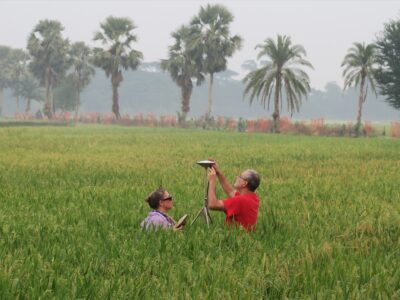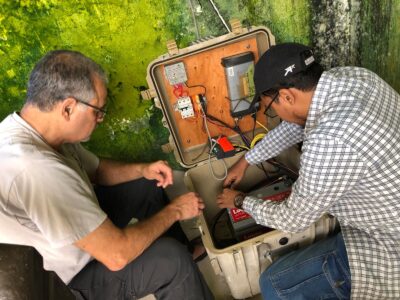
The next day we all went to two sites to the southeast of Barisal. Our team of nine people are resurveying old Survey of Bangladesh (SoB) monuments to determine how fast the coastal zone of Bangladesh is sinking. Bangladesh, home to the world’s largest delta, is sinking, as are all deltas, worsening the effect of sea level rise. Here, unlike the Mississippi Delta, the rivers still bring an amount of sediments to fill the area and maintain the land. But with increasing sea level rise, it is important to know the rates that the land is going down.
Getting to the day’s sites involved two ferry crossings. The first was on the busy main N-S road over the large Bighai or Payra River.

A huge bridge is under contraction, but until it is done, a ferry is needed. The second ferry was on a smaller river heading east. Both would eventually cause problems. When we finally made it across the rivers and finished the long drives and got to the site, we found it under lots of trees. The landowner had told the SoB that he was going to build his house and garden there back in 2002 when the monuments were installed.

However, they did not listen and shift the monument to the site he suggested in an open field. We could not cut down enough trees to make it a good site. After many discussions and phone calls, the Institute of Water Modeling was able to arrange for a surveyor to join us tomorrow. We put the GPS in a nearby open field with a good sky view. When we return, the surveyor will do a leveling survey.

He will determine the elevation difference between the monument and the GPS with the temporary mark we created. The delays meant it was already after 2 PM before we finished the site. We headed south along a bad road to the next one. We weren’t sure of the road to take, but both Google Maps and local guides took us to a dead end. There was a large tree fallen across the road, with people slowly sawing it into pieces. Clearing the road would take days.

We looped back and found the site off a road that was on no map. At least it had a very good sky view. We installed the site and arranged for guards as darkness fell. We had managed two sites that were difficult to get to. Unfortunately, they were also difficult to get back from. My car left early to pick up the site near Barisal University on the way home while the others finished the installation. However, we first found the large ferry near the city of Patuakhali was jammed with traffic.

It took hours to get across and with the extra stop, we didn’t reach our hotel until after 10 PM, around the same time as the other team. We gave up picking the rest of the previous days’ sites and arranged for security to continue another day. Knowing how long cooking food takes at the hotel restaurant, we asked our floor boy what could be made quickly. As a result all nine of us had chicken biryani for dinner.

That convinced me that it was time to move to Kuakata, a beach resort town on the coast as our base. No ferries. The three river crossings now all have bridges. It is a long drive from Patuakhali, but no longer than the time we spent waiting for a ferry. To make this work, the teams split up. One car headed south to install stations on the way to Kuakata, while my team first headed north to pick up the two earlier sites.

We had a late start from checking out and trying to fit everything into the vehicles. The pickups went well, but the drives took longer than I expected. With the wait at the ferry, we got to the first site late in the afternoon. The surveyor went to work and made an excellent tie between our GPS in the field and the monument, getting the height difference with a uncertainty of 1 millimeter. We dropped him off at his nearby home town and got to the other site after dark.

We made the required checks and measurements by flashlight. Returning to the main road, this time our problem was the small ferry. A truck broke its axle and it took hours to get it off the ferry. We spent the time waiting at the ferry terminal drinking tea and watching cricket. It was almost two hours before we got to the other side. We stopped for dinner in Patuakhali and finally reached Kuakata a little before midnight. The other team also had bad luck.

They quickly picked up the station at the university and headed to a site in Patuakhali. It had a different, taller monument and our tripods would not work. The SoB will lend a different tripod to Hasnat for occupying that site later. They then drove to the next site and found it tilted and in the river. It was now good for helping people climb out of the river after washing, but useless for us. They finally got to install a site along the road to Kuakata.

Still, they finished well before us and had fresh barbecued fish at the hotel for dinner. With the late nights, we all slept in a little and had breakfast at 8. The next site turned out to be 100 feet from the back of our hotel on the road parallel to the beach. I hadn’t spotted it during a morning walk. That was because it was in a squatter’s home. The walls, trees and rooftop squash were a problem for the sky view. The person living there was very accommodating with changing his home.

He cut back some trees and lowered netting that had squashes growing on it. We tried several different configurations with different tripods to finally get the one that was both stable and gave us the highest antenna. We needed to be above all the walls and squash for the sky view. It took a while and we had to stand on stools to use the tribrach for leveling and centering the tripod. Most of the morning was gone and we still had two more sites to do today. Each team picked one and we all headed off.

The first one done would pick up the previous day’s site. Even so, it would be a shorter day than the last two, and we were in a beach resort town, if we ever managed any free time.




